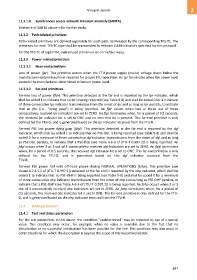Page 857 - 5G Basics - Core Network Aspects
P. 857
Transport aspects 2
11.3.1.8 Synchronous access network transient anomaly (SANTA)
Existence of SANTA clause is for further study.
11.3.2 Path-related primitives
Path-related primitives are defined separately for each path, terminated by the corresponding TPS-TC. The
primitives for each TPS-TC type shall be represented by relevant OAM indicators specified for this protocol.
For the TPS-TC of type PTM, path-related primitives are for further study.
11.3.3 Power-related primitives
11.3.3.1 Near-end primitives
Loss of power (lpr): This primitive occurs when the FTU power supply (mains) voltage drops below the
manufacturer-determined level required for proper FTU operation. An lpr terminates when the power level
exceeds the manufacturer-determined minimum power level.
11.3.3.2 Far-end primitives
Far-end loss of power (flpr): This primitive detected at the far end is reported by the lpr indicator, which
shall be coded 1 to indicate that no lpr is being reported (see Table 9-8) and shall be coded 0 for a minimum
of three consecutive lpr indicator transmissions from the onset of lpr and as long as lpr persists, to indicate
that an flpr (i.e., "dying gasp") is being reported. An flpr occurs when two or three out of three
consecutively received lpr indicators are set to ZERO. An flpr terminates when, for a period of 0.5 seconds,
the received lpr indicator bit is set to ONE and no near-end los is present. This far-end primitive is only
defined for the FTU-O, and is generated based on the lpr indicator received from the FTU-R.
Far-end PSE lost power dying gasp (fdgl): This primitive detected at the far end is reported by the dgl
indicator, which shall be coded 1 to indicate that no PSE-DGL is being reported (see Table 9-8) and shall be
coded 0 for a minimum of three consecutive dgl indicator transmissions from the onset of dgl and as long
as PSE-DGL persists, to indicate that a PSE-DGL (see Table A.6-3 of [ITU-T G.997.2]) is being reported. An
fdgl occurs when 2 or 3 out of 3 consecutively received dgl indicators are set to ZERO. An fdgl terminates
when, for a period of 0.5 seconds, the received dgl indicator bit is set to ONE. This far-end primitive is only
defined for the FTU-O, and is generated based on the dgl indicator received from the
FTU-R.
Far-end PSE power fail with off-hook phone during NORMAL OPERATIONS (fohp): This primitive (see
clause A.7.4.1.2 of [ITU-T G.997.2]) detected at the far end is reported by the ohp indicator, which shall be
coded 1 to indicate that no PSE-OHP is being reported (see Table 9-8) and shall be coded 0 for a minimum
of three consecutive ohp indicator transmissions from the onset of ohp and as long as PSE-OHP persists, to
indicate that a PSE-OHP (see Table A.6-3 of [ITU-T G.997.2]) is being reported. An fohp occurs when 2 or 3
out of 3 consecutively received ohp indicators are set to ZERO. An fohp terminates when, for a period of
0.5 seconds, the received ohp indicator bit is set to ONE. This far-end primitive is only defined for the FTU-
O, and is generated based on the ohp indicator received from the FTU-R.
11.4 OAM parameters
11.4.1 Test and status parameters
For the test parameters in this clause, the condition "undetermined" may be reported by use of a special
value. This condition may occur, for example, when no value is available due to the fact that no
initialization or no successful initialization has been possible for this line. This condition may also occur in
other situations for which the description is beyond the scope of this Recommendation.
847

